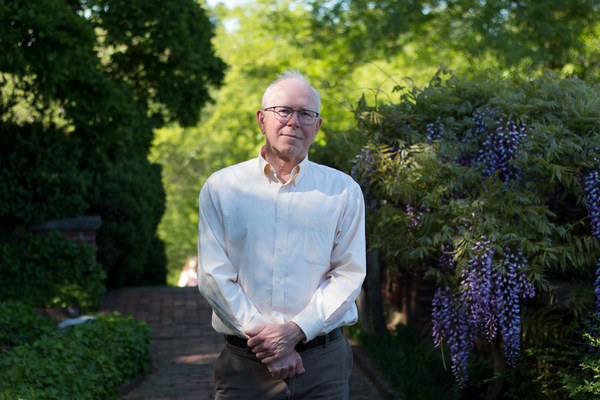Michael McCormick, Francis Goelet Professor of Medieval History and chair of the Initiative for the Science of the Human Past (SoHP) at Harvard University, was a visiting scholar in Byzantine Studies in spring 2019. His public lecture, “From the Fall of Rome to Byzantium: New Light from DNA, Ice Cores, and Harvard’s Science of the Human Past,” proposed a new day in the discovery of ancient and medieval civilization.
How are you investigating sixth-century plague?
The Max Planck-Harvard Research Center for the Archaeoscience of the Ancient Mediterranean (MHAAM), which I direct in Cambridge and my colleague Johannes Krause directs from the Department of Archaeogenetics of his Max Planck Institute in Germany, looks, among other things, at ancient pathogens. Skeletons in mass or strange burials might preserve traces of the ancient pathogen that killed the person. These are potential victims of the great epidemics many of us increasingly think played a role in the fall of the Roman empire and transformations in the late antique and early Byzantine period.
Our most recent article shows the bacterium Yersinia pestis (bubonic plague) in an Anglo-Saxon cemetery near Cambridge, England, and presents the first robustly identified victims from the Mediterranean coast of France and Spain. The Anglo-Saxon find was surprising to me personally, but even more surprising is provisional analysis of its genome, possibly suggesting this particular bacterium is very close to the beginning of the explosion of the disease in 541 and 542. Potentially, the Justinianic pandemic covered the entire Mediterranean and out into the Atlantic, very early and very fast.
What can humanists learn from scientists, and how does one foster interdisciplinary investigations like our Plant Humanities Initiative with JSTOR Labs?
MHAAM also looks at migration and mobility. In the last five years or so, it's become clear that human beings have always been migrating. MHAAM looks at this big story from the point of view of ancient DNA, which tells you who your parents were. If you can find a bunch of your parents’ relatives in one place, and you in another place, that might be a good indicator that somebody moved.
Then there’s isotopic evidence. Your body takes on isotopic signals from its environment—water it drinks, food it eats, and so forth. Many scholars now use ancient people’s teeth to help determine where they were born versus where they wound up.
When we reach the Bronze Age and later, we can start adding texts to genetic signals and isotopes. Words borrowed from different language groups travel around the Mediterranean, for example. Add to that the archaeological record of things that moved: pots, coins.
It’s really cool to be able to lay next to each other completely independent types of evidence. All of this adds to the record of the human past, forcing us not to abandon our wonderful texts, but to analyze their testimony with new knowledge. Often we discover the texts were not actually saying what we thought they were. This fantastic new data is breathing new life into historical and philological investigation.
Most of the wonderful scientists I’m privileged to collaborate with are very curious people. If you lay out your questions in a clear enough fashion, they’re intrigued. It takes a lot of talking, careful listening, clear thinking, explanation, questioning. Over time, you come to learn to speak each other’s language. Historians can speak science, scientists can speak history. We learn to make little accommodations to help the other understand our lingo. The most important thing is establishing this tradition of speaking with respect but still asking sharp questions.
For example, I work on the Historical Ice Core Project at the Initiative for the Science of the Human Past (SoHP) in collaboration with Paul Mayewski, director of the Climate Change Institute at the University of Maine. Paul played a great role in a 2009 Dumbarton Oaks workshop I organized on climate change and the fall of the Roman empire. Paul has come to ask really penetrating historical questions. When people look in future at some of our articles and say, “oh, that question or observation must come from a historian,” it will actually have come from one of America’s great paleoclimate scientists.
Who have you collaborated with here?
Dumbarton Oaks is a scholar’s paradise, and you don’t have to die to get there. I’ve learned immensely from the fellows. Alex Tokovinine discussed the apparent impact in Maya Central America of the volcano (whose geographic location our project identified in 2018 from our Swiss ice core) that set off the late antique Little Ice Age. Talking to Sara Zewde about tracking Olmsted’s movements gave me thoughts of my own about Byzantine civilization. I’ve gotten new texts for my work on plague from Dan Caner, who generously showed me everything he found. I've been at Dumbarton Oaks for 40 years, and this is the moment I’ve seen the most intellectual interaction among the different programs. That’s an incredible tribute to the institution and its director.
Julia Ostmann is postgraduate writing and reporting fellow at Dumbarton Oaks. Photo by Elizabeth Muñoz Huber, postgraduate digital media fellow.

